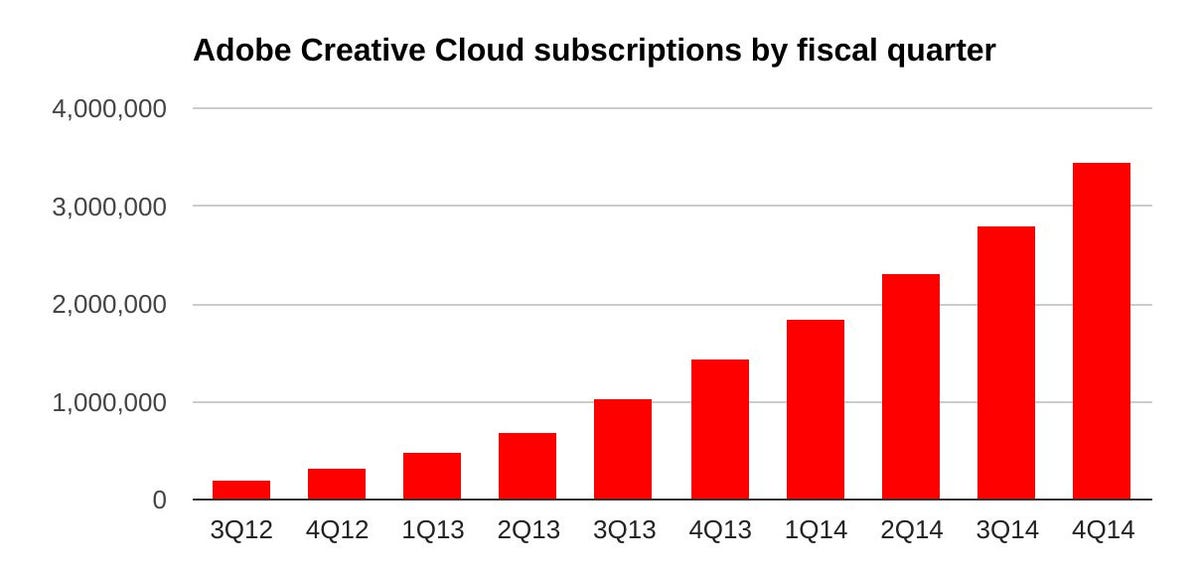
Stephen Shankland/CNET
Taking a new step toward becoming a services company, Adobe Systems has signed a deal to acquire Fotolia, one of a handful of “microstock” companies that license photos for use in ads, brochures and other publications.
The company announced the acquisition agreement, for about $800 million in cash, as it reported fourth-quarter financial results Thursday. Acquiring Fotolia puts Adobe into direct competition with Shutterstock, Getty Images’ iStockphoto, and other royalty-free licensing companies, but it also could make Adobe more influential as a supplier of content as well as the creative tools used to create that content.
Stock art has been a staple of the photography business, supplying customers with images of businesspeople shaking hands, children at play, healthy salads and other photos that customers need over and over again. The Internet rewrote the stock-art business by letting millions of photo enthusiasts make a little money by selling their photos — not necessarily enough to be a full-time job, but often enough to turn a hobby into useful income. Now Adobe hopes to become a big middleman in the business.
“As we integrate Fotolia, we believe our members will use Creative Cloud as the place to discover and buy great content — and also as a place where they can sell and showcase their work,” said David Wadhwani, general manager of Adobe’s digital media business, in a blog post.
By getting into the business, Adobe furthers a fundamental transition into more of a services company, a radical overhaul for a company that a decade ago mostly made money by shipping installation CD-ROMs to customers. The Fotolia service dovetails with its contentious shift from traditional software licensing to its Creative Cloud subscription. Other examples of Adobe’s services push include its Omniture tools to let publishers and marketers track Web site usage, Acrobat’s document-management options, and the Behance social network for sharing, discovering and promoting creative work.
It’s not clear exactly how Adobe will change Fotolia, but it’s not going to be a freebie added into Creative Cloud subscriptions, Adobe said in a statement.
Related stories
- Survey shows polarized opinions about Adobe Creative Cloud
- Checking out Photoshop for Chromebooks: Network-computing revived
- Lightroom 5.7 supports new Canon and Nikon cameras, iPhone 6
- Creative pros like Macs, but Adobe cozies up with Microsoft
“It’s premature to outline the exact type of integration and pricing we could offer, however we do anticipate this will be a value-add service and there will be extra cost associated with using it for Creative Cloud members,” Adobe said. Fotolia is largely a European company, but Adobe plans to increase its profile in the US, the company said.
The Creative Cloud, which grants subscribers access to Adobe software like Photoshop and Illustrator for $50, £47 or AU$50 per month, has been at the center of the company’s business transition. Although subscriptions alienated some customers who preferred software that would keep working forever once licensed, the company has steadily added subscribers. Subscriptions mean revenue arrives predictably instead of being tied to occasional software updates, and it lets the company deliver software and service updates continuously instead of holding them back for major upgrades.
“2014 was a pivotal year for Adobe as we completed our business model transition,” Adobe Chief Financial Officer Mark Garrett said in a statement. “In 2015 we expect revenue and earnings to grow sequentially every quarter during the year.”
In the quarter that ended November 30, Adobe added 644,000 new Creative Cloud subscribers, bringing the total to 3.45 million. Its revenue was mostly flat from the year-ago quarter, rising from $1.04 billion to $1.07 billion. Its earnings per share of 36 cents outpaced analyst expectations of 30 cents, but the company’s stock price dipped by 11 cents in after-hours trading to $69.74.
One reason for the lackluster reception could be that while Adobe’s Creative Cloud subscription rates are rising, it appears many people are opting for the cheaper $10 per month Photoshop Photography Program, which includes Photoshop and Lightroom but not the other major titles in the $50 plan.
That means that a surprisingly large growth in subscribers was offset by lower average revenue per user (ARPU), said RBC Capital analyst Ross MacMillan in a report. That means annual recurring revenue, a key measure of the success of the subscription business, doesn’t change much, he said.
“Management is focused on growing the subscriber base rather than ARPU today,” MacMillan said.
The Fotolia acquisition should help that situation, though.
“Stock content is critical for creatives and is a large and fast-growing multi-billion dollar market,” Chief Executive Shantanu Narayen said in an earnings call. “We intend to integrate Fotolia into Creative Cloud, resulting in higher ARPU and increased revenue.”
Overall, Adobe said it expects its revenue to increase from $4.15 billion in fiscal 2014 to $4.85 billion in fiscal 2015, a 17 percent increase.




